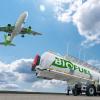
Mountain regions have a large potential for hydropower that cannot be harnessed effectively by conventional technologies. IIASA researcher Julian Hunt and an international team of researchers developed an innovative hydropower technology based on electric trucks that could provide a flexible and clean solution for electricity generation in mountainous regions.
In our transition towards a more sustainable future, hydropower will likely grow in importance as a renewable energy source. Despite its potential, innovation in hydropower technology has been slow in the last century. Conventional methods used today rely on two connected reservoirs with different water levels where the potential energy of the water is converted into electricity.
In steep mountain regions, the potential for generating electricity from a small stream of water is high, however, the hydropower potential of these regions remains untapped as it requires storage reservoirs, which have environmental and social impacts. IIASA researcher Julian Hunt and an international team of researchers developed a new technology called Electric Truck Hydropower that could become a key method for electricity generation in steep mountainous regions. The results of the study have been published in the journal Energy.
Electric Truck Hydropower would use the existing road infrastructure to transport water down the mountain in containers, applying the regenerative brakes of the electric truck to turn the potential energy of the water into electricity and charge the truck's battery. The generated energy could then be sold to the grid or used by the truck itself to transport other goods. Electric Truck Hydropower could also generate electricity in combination with solar and wind resources or provide energy storage services to the grid.
“The ideal system configuration is in mountainous regions with steep roads, where the same electric trucks can be used to generate hydroelectric power from different locations. This increases the chances that water will be available,” says Hunt.
 © Hunt et al. (2022)
© Hunt et al. (2022)
Figure: Schematic description of the system where the empty truck moves up the mountain to collect the containers filled with water at the charge site and the truck with the full container goes down the mountain generating electricity. The water is then unloaded at the discharge site.
The proposed technology is an innovative, clean source of electricity that is competitive with solar, wind, and conventional hydropower. Cost estimates show that the levelized cost of Electric Truck Hydropower is US$30-100 per MWh, which is considerably cheaper than conventional hydropower at US$50-200 per MWh.
The environmental impacts of Electric Truck Hydropower are also significantly smaller than that of conventional hydropower.
“This technology does not require dams, reservoirs, or tunnels, and it does not disrupt the natural flow of the river and fish passage. The system requires only roads, which already exist, charging and discharging stations similar to small car parks, a battery facility connected to the grid, and the trucks,” explains Hunt.
When looking at the global reach of this technology, the research team estimated that Electric Truck Hydropower could generate 1.2 PWh electricity per year, which is equivalent to about 4% of global energy consumption in 2019. The technology could harness the previously untapped potential for hydropower on steep mountain ranges. The regions with the highest potential are the Himalayas and the Andes.
“It is an interesting electricity generation alternative due to its high flexibility. For example, if a country is in an energy crisis, it can buy several electric trucks to generate hydropower. Once the crisis is over, the trucks can be used to transport cargo,” Hunt concludes.
Reference
Hunt, J., Jurasz, J., Zakeri, B., Nascimento, A., Cross, S., Schwengber ten Caten, C., de Jesus Pacheco, D., Pongpairoj, P., Leal Filho, W., Tomé, F., Senne, R., van Ruijven, B. (2022). Electric Truck Hydropower, a Flexible Solution to Hydropower in Mountainous Regions. Energy DOI: 10.1016/j.energy.2022.123495
News

22 July 2024
Are sustainable aviation fuels truly sustainable?

17 July 2024
Forests endure as carbon sink despite regional pressures

16 July 2024
